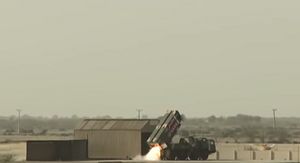On January 31, Pakistan’s Army Strategic Forces Command conducted a test of its Nasr/Hatf-IX nuclear-capable, close-range ballistic missile. The test was the second involving the Nasr to take place in January 2019.
The test was “was aimed at testing the extreme inflight maneuverability, including the end flight maneuverability,” a statement released by Pakistan’s Inter-Services Public Relations noted. The Nasr was “capable of defeating, by assured penetration, any currently available BMD (ballistic missile defense) system in our neighborhood or any other system under procurement / development,” the statement added.
The emphasis on ballistic missile defense comes as India anticipates the delivery of S-400 air defense systems from Russia by October 2020. The Russian system, depending on its configuration, is capable of conducting endo- and exoatmospheric interceptions of ballistic and cruise missiles.
This month’s Pakistani Nasr tests also come shortly after the release of the United States’ 2019 Missile Defense Review, which included an acknowledgement that the United States “has discussed potential missile defense cooperation with India.” The United States and India have consulted on missile defense since at least the mid-2000s, but India has not procured any U.S. systems to date.
The MDR described the context of U.S. talks with India on missile defense as stemming from the fact that a “number of states in South Asia are developing an advanced and diverse range of ballistic and cruise missile capabilities.” Pakistan was not mentioned by name.
This month’s Nasr tests also follow the release of the Indian Army’s 2018 Land Warfare Doctrine.
The latest Nasr test follows another just days earlier. According to ISPR, that test “involved launching of quad salvo for desired effects. Nasr is a high precision, shoot and scoot Weapon System with the ability of in-flight maneuverability.” Another test in 2017 saw the range of the Nasr extended from 60 km to 70 km.
Pakistan adopted the Nasr in response to India’s plans to improve its mobilization times under the Cold Start doctrine. “The Cold Start doctrine exists for conventional military operations. Whether we have to conduct conventional operations for such strikes is a decision well thought through, involving the government and the Cabinet Committee on Security,” General Bipin Rawat, India’s army chief, noted in a January 6, 2017, interview.
The deployment of the Nasr in Pakistan has raised concerns about accidental nuclear use in Pakistan. As The Diplomat‘s Rajeswari Rajagopalan explained last week, “Such weapons have to be forward deployed, and control of these weapons need to be delegated to lower levels of command, which increases probability of these weapons being used without being authorized by the central command.”

































